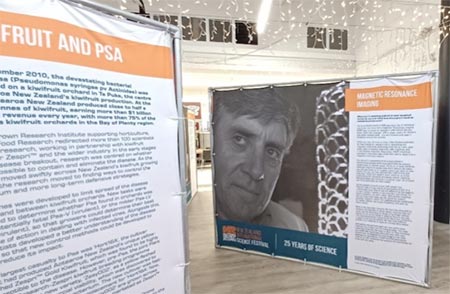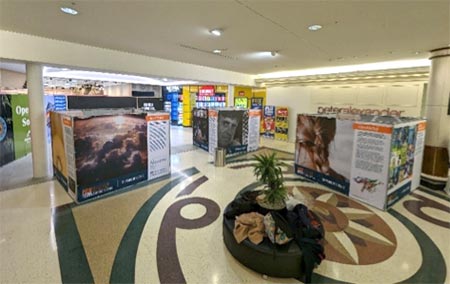2023 International Science Festival celebrates the legacy of Sir Paul Callaghan
3 December, 2023
When you're spooning yoghurt on your breakfast cereal, do you ever think how the yoghurt could be related to a brain scan?
You've probably heard of MRI scanning. Either you or someone else in your family may have had a Magnetic Resonance Imaging (MRI) scan to check for disease in soft tissues like the brain, heart and muscles. MRI is super useful for doctors and other medical staff - it's non-invasive and used in hospitals around the country.
What you may not know is that a New Zealand scientist, Sir Paul Callaghan, played a role in developing the Magnetic Resonance technology that has so many uses today, both in hospital diagnostic MRI machines, and in the NMR machines you'll find in chemistry labs.

The International Science Festival '25 Years of Science' exhibit in Meridian Mall, Dunedin, July 2023
This year the International Science Festival in Dunedin curated a '25 Years of Science' exhibit that included a celebration of the role that Sir Paul Callaghan played in developing Magnetic Resonance technology.
You wouldn't necessarily think a story about a complicated physics technique would include yoghurt, mayonnaise, or tomato sauce. Turns out it does, because although they're all liquids, they don't behave like water: you can pile them up on a spoon (which you can't do with water) but you can also spread them with a knife and they 'flow'. While this doesn't seem weird to us, it has implications for industrial processes and for medicine (because blood also behaves in a similar way). All of these can be described as 'soft matter'.
All the plastics around us are 'soft matter' too. They're made of long chains of hydrocarbons and at a microscopic level they're not too different to the yoghurt on your cereal in terms of how they flow and diffuse. Sir Paul's research into soft matter (and 'porous materials' like our body cells) really set the scene for today's polymer research (which has applications like windshields for fighter planes, new types of plastics and even for heart valves).

25 years of science exhibit, Meridian Mall, Dunedin
Back in the late 20th Century, Sir Paul was using MRI to measure the sap flow in wheat seeds, showing that you could use this technique to study living things, without having to cut up the seeds or destroy them in any way. This was very fundamental research and led to him publishing a paper in the journal Nature. Sir Paul took MRI and applied it to materials in ways no one had done before.
Sometimes the current tools you have aren't quite right for the problem you're trying to solve. The really important thing for this story is that Sir Paul improved the NMR/MRI technology along the way. With each experiment, he adapted the technology to the need, pushing the boundaries of NMR and MRI techniques, coming up with solutions that support the technology we know and use today.
The 25 Years of Science exhibit spent 34 days in Dunedin's Meridian Mall from 30 June - 2 August 2023.


